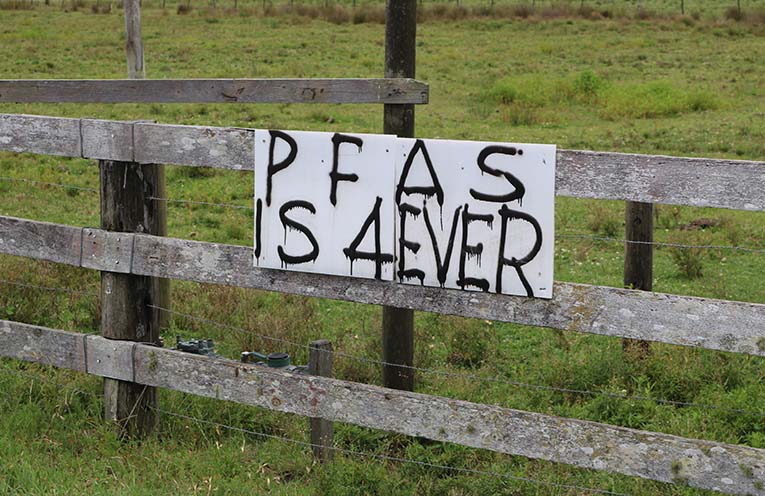
MEDOWIE residents Michael Walton and Paul Rooms appeared last week as witnesses to an inquiry into ‘forever chemical’ contamination in waterways and drinking water supplies throughout NSW.
The inquiry, overseen by a NSW Upper House select committee, rolled into Newcastle on Tuesday, 4 February, following hearings and site visits in the Blue Mountains, where water samples recently collected in Katoomba revealed high levels of PFAS (Per- and polyfluoroalkyl substances).
 Advertise with News of The Area today.
Advertise with News of The Area today.It’s worth it for your business.
Message us.
Phone us – (02) 4981 8882.
Email us – media@newsofthearea.com.au
The acronym PFAS refers to a group of over 4000 chemicals, many of which are very effective at resisting heat, stains, grease and water.
This makes them useful chemicals for a range of applications, and notoriously difficult to break down, hence the nickname ‘forever chemicals’.
In the Hunter, the historic use of PFAS in fire-fighting foams at the Williamtown RAAF base has resulted in extensive contamination and the establishment of management zones around the site.
Fronting the inquiry last Tuesday, Mr Rooms expressed concerns over “recent levels of PFAS and PFOA [Perfluorooctanoic acid] located at the Pacific Dunes golf course in Medowie and its spread outside the so-called red zone”.
Mr Rooms’ interest in the issue began when he noticed “foam” and “bubbles” in watercourses running through the Pacific Dunes golf course, where he resides.
He and Mr Walton claim that an independent test revealed levels of PFAS in the sample taken from Pacific Dunes to be approximately 54 times the Australian standard for fresh water.
The PFAS National Environment Management Plan 2.0 has four fresh water ecological criteria for comparison based on specific exposure scenarios.
From the evidence given at the inquiry, it is not clear which criterion was used by Mr Rooms and Mr Walton.
The pair advocated for more extensive PFAS testing outside the Williamtown “red zone” area, and expressed a lack of confidence in government agencies to effectively manage the issue.
“I would say there is systemic organisational failure across multiple organisations, and I believe one of the things that stems from this is because the cost of knowing the truth of the spread of PFAS and PFOA – the economic, business, health and environment costs are such that the executive really don’t want to know,” Mr Walton said.
Hunter Water, which manages the Lower Hunter’s drinking water from “catchment-to-tap”, has been monitoring the region’s drinking water for PFAS for the past eight years.
Samples are taken at the Hunter’s six drinking water treatment plants, and at 83 locations across the drinking water network.
“The results demonstrate that the drinking water we supply to our customers and community is safe,” the water body said in a statement to NOTA.
“We have a comprehensive monitoring program for both our raw (groundwater, dams and catchments) and treated (water treatment plants and drinking water distribution network) waters, which includes PFAS.
“In the vicinity of Medowie, our sampling includes monitoring of raw water from Grahamstown Dam, Campvale Canal and at Pump Station 12 in the Tomago Borefield.
“Treated water in the Medowie area is monitored at Grahamstown Water Treatment Plant and at three locations in the drinking water distribution network.”
The statement said that Hunter drinking water “remains safe”, meets the current Australian Drinking Water Guidelines for PFAS, and that “analysis indicates that it will meet the requirements of the proposed new ADWG PFAS guidelines”.
“These guidelines are derived on the basis of human health risk over a lifetime of exposure and apply to the treated water supplied to customers, as opposed to raw water from the drinking water catchments.”
Following last week’s inquiry, Hunter Water confirmed it has not undertaken specific testing at the Pacific Dunes golf course.
“In assessing the issues raised by the submission, Hunter Water has identified new information regarding the historic vehicle accident and related firefighting activity within the Tomago Sandbeds catchment at Medowie,” the statement said.
“Hunter Water has written to the NSW Environment Protection Authority and will work with them and other relevant agencies as required.”
Sampling from Hunter Water’s closest groundwater pump station (Pump Station 12) south of the golf course has detected PFAS on one occasion, at a very low concentration.
Sampling undertaken in Campvale Canal regularly shows the presence of concentrations of PFAS compounds higher than at Pump Station 12, consistent with the urban nature of the surrounding environment.
Around 500 samples have been analysed from Campvale Canal since 2016 as part of the routine monitoring program, with the sum of PFOS and PFHxS (Perfluorohexanesulfonic acid) consistently around 0.01 micrograms per litre since sampling commenced.
At this concentration, authorities believe the PFAS contribution from Campvale Canal does not impact the safe supply of drinking water from Grahamstown Water Treatment Plant.
The NSW Environment Protection Authority (EPA) confirmed to NOTA it has not seen results from water sampling undertaken by the community in Medowie or Pacific Dunes.
“Medowie and Pacific Dunes are not part of the Williamtown Management Area, however the EPA is aware of community concerns and we are investigating,” it said in a statement.
Pacific Dunes CEO David Wightman said the issue of potential contamination at the golf course had not been raised with management ahead of the inquiry, and that localised testing had not occurred on site to his knowledge.
In May 2018, the Federal Government’s PFAS Expert Health Panel released a report into health effects from forever chemical exposure.
While it concluded that there is no current evidence to suggest an increase in overall health risk related to PFAS exposure, it also said health effects cannot be ruled out.
By Doug CONNOR